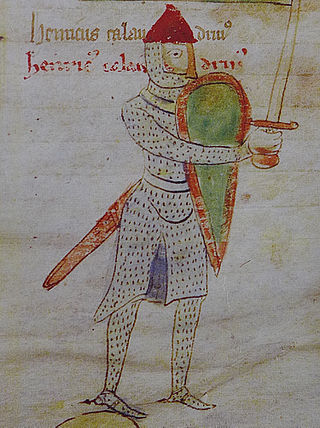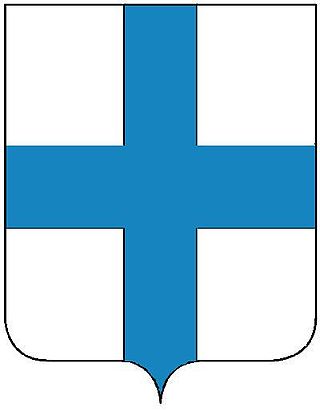
Markward von Annweiler (died 1202) was Imperial Seneschal and Regent of the Kingdom of Sicily.

Markward von Annweiler (died 1202) was Imperial Seneschal and Regent of the Kingdom of Sicily.
Markward was a ministerialis, that is, he came not from the free nobility, but from a class of unfree knights and administrators whose purpose was to serve loyally the Imperial administration in any capacity. During the reign of the Emperor Frederick Barbarossa, Markward became one of the most important figures in the administration.
Markward can be proved at the latest since the Diet of Pentecost. From 1184, Markward served Barbarossa's son Henry VI in Italy. Henry appointed him Margrave of Ancona and Count of Abruzzo, placing him in a highly strategic position in north-central Italy. After the death of Henry, Markward at first supported his widow Constance of Sicily, but later found himself her enemy. He had been excommunicated by Popes Celestine III and Innocent III, who were trying to take over lands in central Italy.
Markward stayed in Italy, and became a supporter of Philip of Swabia, the brother of Henry. Markward's political and military activities caused great problems for the Popes, whose control of Sicily gradually weakened. Two years after Constance's death (1198), Philip gave Markward the lordship of Palermo, where the under-age heir, the future Emperor Frederick II, was resident. Despite the opposition of Innocent III, Markward became Guardian of Frederick II and Regent of Sicily. However, Markward died within a few years. Markward died at a town called Patti having succumbed to surgery for kidney stones. [1]
He was succeeded in Palermo by William of Capparone.

The Hohenstaufen dynasty, also known as the Staufer, was a noble family of unclear origin that rose to rule the Duchy of Swabia from 1079, and to royal rule in the Holy Roman Empire during the Middle Ages from 1138 until 1254. The dynasty's most prominent rulers – Frederick I (1155), Henry VI (1191) and Frederick II (1220) – ascended the imperial throne and also reigned over Italy and Burgundy. The non-contemporary name of 'Hohenstaufen' is derived from the family's Hohenstaufen Castle on Hohenstaufen mountain at the northern fringes of the Swabian Jura, near the town of Göppingen. Under Hohenstaufen rule, the Holy Roman Empire reached its greatest territorial extent from 1155 to 1268.

Otto IV was the Holy Roman Emperor from 1209 until his death in 1218.

Pope Innocent III, born Lotario dei Conti di Segni, was the head of the Catholic Church and ruler of the Papal States from 8 January 1198 until his death on 16 July 1216.

Frederick Barbarossa, also known as Frederick I, was the Holy Roman Emperor from 1155 until his death 35 years later. He was elected King of Germany in Frankfurt on 4 March 1152 and crowned in Aachen on 9 March 1152. He was crowned King of Italy on 24 April 1155 in Pavia and emperor by Pope Adrian IV on 18 June 1155 in Rome. Two years later, the term sacrum ("holy") first appeared in a document in connection with his empire. He was later formally crowned King of Burgundy, at Arles on 30 June 1178. He was named Barbarossa by the northern Italian cities which he attempted to rule: Barbarossa means "red beard" in Italian; in German, he was known as Kaiser Rotbart, which in English means "Emperor Redbeard." The prevalence of the Italian nickname, even in later German usage, reflects the centrality of the Italian campaigns to his career.

Year 1198 (MCXCVIII) was a common year starting on Thursday of the Julian calendar.

Frederick II was King of Sicily from 1198, King of Germany from 1212, King of Italy and Holy Roman Emperor from 1220 and King of Jerusalem from 1225. He was the son of emperor Henry VI of the Hohenstaufen dynasty and Queen Constance of Sicily of the Hauteville dynasty.

Conrad, a member of the Hohenstaufen dynasty, was the only son of Emperor Frederick II from his second marriage with Queen Isabella II of Jerusalem. He inherited the title of King of Jerusalem upon the death of his mother in childbed. Appointed Duke of Swabia in 1235, his father had him elected King of Germany and crowned King of Italy in 1237. After the emperor was deposed and died in 1250, he ruled as King of Sicily until his death.

Constance I was reigning Queen of Sicily from 1194–98, jointly with her spouse from 1194 to 1197, and with her infant son Frederick II, Holy Roman Emperor, in 1198, as the heiress of the Norman kings of Sicily. She was also Holy Roman Empress and later Dowager by marriage to Henry VI, Holy Roman Emperor.

The Kingdom of Sicily was a state that existed in the south of the Italian Peninsula and for a time the region of Ifriqiya from its founding by Roger II of Sicily in 1130 until 1816. It was a successor state of the County of Sicily, which had been founded in 1071 during the Norman conquest of the southern peninsula. The island was divided into three regions: Val di Mazara, Val Demone and Val di Noto.

Walter III of Brienne was a nobleman from northern France. Becoming Count of Brienne in 1191, Walter married the Sicilian princess Elvira and took an army to southern Italy to claim her inheritance. He became Prince of Taranto in her right in 1201 but died fighting before he could establish himself as King of Sicily.

Henry of Kalden was a ministerialis in the service of the German kings Henry VI, Philip, Otto IV, and Frederick II.

Dipold, known in German as Diepoldvon Schweinspünt, was a German ministerialis who was raised to the Duchy of Spoleto in 1209. Of Bavarian origin, he was a reputed younger son of Berthold II of Vohburg and Adelaide of Ballenstedt. He was originally a vassal of the count of Lechsgemünd. His career in the Mezzogiorno was marked by continual raids and sieges, battles, and sacks recounted in exhaustive detail by Richard of San Germano, a monk of the abbey whose lands were especially hard hit.
Walter of Palear was the chancellor of the Kingdom of Sicily under Queen Constance and the Emperor Henry VI. He was also the bishop of Troia (1189–1208) and later bishop of Catania.

Berthold IV, a member of the House of Andechs, was Margrave of Istria and Carniola. By about 1180/82 he assumed the title of Duke of Merania, referring to the Adriatic seacoast of Kvarner which his ancestors had conquered in the 1060s and annexed to Istria and Carniola.
Constance of Aragon was an Aragonese infanta who was by marriage firstly Queen of Hungary, and secondly Queen of Germany and Sicily and Holy Roman Empress. She was regent of Sicily from 1212 to 1220.
Guglielmo Grasso, sometimes anglicized William Grassus, was a Genoese merchant, pirate and admiral.

Richard (Riccardo) Filangieri (c.1195–1254/63) was an Italian nobleman who played an important part in the Sixth Crusade in 1228–9 and in the War of the Lombards from 1229–43, where he was in charge of the forces of Frederick II, Holy Roman Emperor, battling forces on the other side, local barons first led by John of Ibelin, Old Lord of Beirut. During the first half of his career Richard was a Ghibelline, but during the second a Guelph. He was a member of the Filangieri family of Sicily.

Henry VI, a member of the Hohenstaufen dynasty, was King of Germany from 1169 and Holy Roman Emperor from 1191 until his death. From 1194 he was also King of Sicily.
Swabian Sicily denotes the period in the history of Sicily during which it was ruled by the Hohenstaufen dynasty, lasting from Henry VI's's accession to the island's throne in 1194 until Manfred of Sicily's defeat by Charles I of Anjou in 1266. It has been particularly researched by German scholars such as Ernst Kantorowicz and Willy Cohn.
John of Cicala was the bishop of Cefalù from 1195 until his death. He owed his rise to his family's alliance with the Staufer. Although he flirted with pro-papal politics in his early years, he was generally a close ally of the Staufer kings Henry VI and Frederick II. He was entrusted with a diplomatic mission to the Ayyubid Sultanate in 1213.